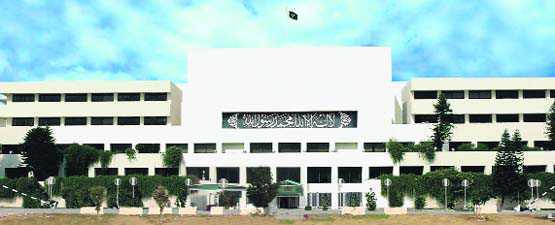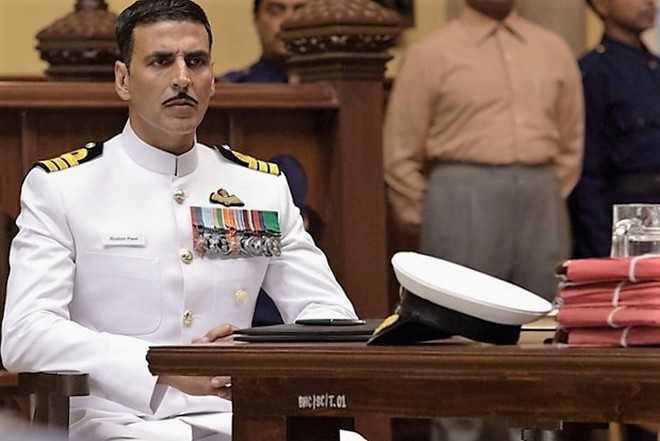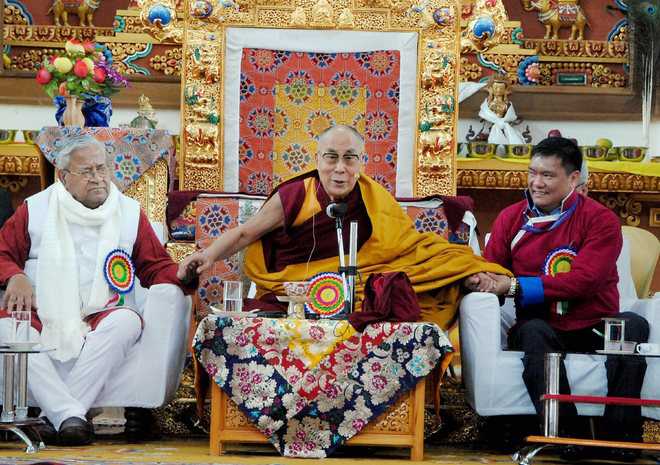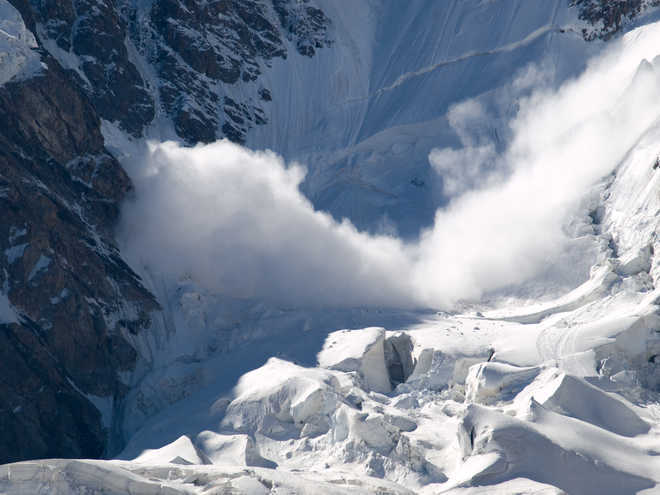Sushma: Blacklist pruning on; passport office for SBS Nagar
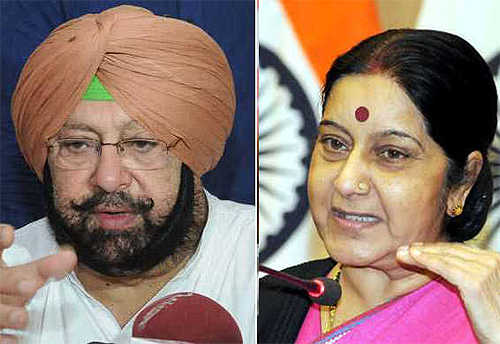 Capt Amarinder Singh and MEA Sushma Swaraj. File photo
Capt Amarinder Singh and MEA Sushma Swaraj. File photoRavi S Singh
Tribune News Service
New Delhi, April 21
External Affairs Minister Sushma Swaraj today informed Punjab Chief Minister Capt Amarinder Singh that the Home Ministry was in the process of gradually pruning the government’s blacklist of Sikh youths named in it for alleged involvement in subversive and anti-India activities.At a meeting with Capt Amarinder, who called on her to inquire about her health, she acceded to the request to open a passport office at Shaheed Bhagat Singh Nagar (Nawanshahr) to facilitate NRIs and their families in the Doaba region. A Punjab Government spokesperson said the proposed passport office would be in addition to the recently sanctioned office at Patiala, which would be inaugurated shortly.(Follow The Tribune on Facebook; and Twitter @thetribunechd)Capt Amarinder reportedly expressed concern over the delay in removing names of Sikh youths from the blacklist. As a result, they have been barred from visiting India. Assuring to take up the issue with the Home Ministry, Swaraj said the government was in the process of pruning the list. The list relates to the days of militancy.Capt Amarinder also urged Swaraj to take up the issue of racist attacks on Punjabis and Sikhs settled abroad at the international level. He also sought protection of victims in such cases. Swaraj responded by saying her ministry was cognisant of the matter and she was personally pursuing the matter to ensure safety of the Sikhs and Punjabis settled overseas.The CM also broached the issue of setting up Punjab-Israel working groups to boost cooperation in areas of security, agriculture and trade. The possibility of floating such groups was earlier discussed between him and the Israeli ambassador in India today.
Sidhu finds anomalies, suspends SDO
Pays surprise visit to Dera Baba Nanak sewage treatment plant
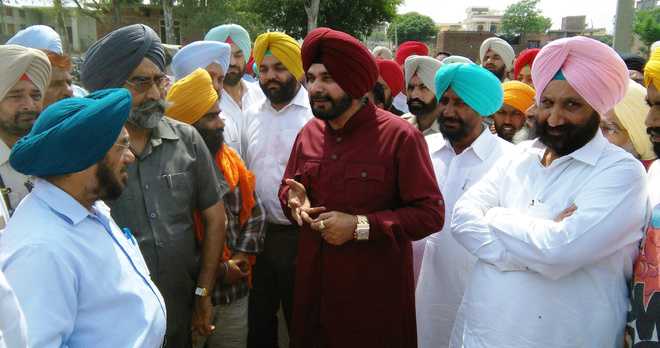 Cabinet Minister Navjot Singh Sidhu with officials of the Water Supply and Sewerage Board at Dera Baba Nanak STP in Gurdaspur on Friday. A Tribune photograph
Cabinet Minister Navjot Singh Sidhu with officials of the Water Supply and Sewerage Board at Dera Baba Nanak STP in Gurdaspur on Friday. A Tribune photographRavi Dhaliwal
Tribune News Service
Gurdaspur, April 21
Local Bodies Minister Navjot Singh Sidhu paid a surprise visit to Dera Baba Nanak Sewage Treatment Plant (STP) and suspended an SDO of the Water Supply and Sewerage Board after finding anomalies in the working of the plant.Sidhu was on a private visit to the town on an invitation of the Dera Baba Nanak sitting Congress MLA Sukhjinder Singh Randhawa. During their conversation, the issue of the virtually defunct STP, constructed at a cost of several crores in 2013, cropped up. Randhawa told him that the plant was dysfunctional ever since it was set up.Sidhu decided to visit the plant. On the way, he stopped at a couple of places and requested residents to reach the site. Once there, he inspected the facilities and came across many shortcomings. He asked residents if they had benefited from the plant or not. Sidhu got livid when almost all residents who had reached there replied in negative. He then placed SDO (maintenance) Jugal Kishore, who was present, under suspension despite the fact that officials tried to defend him.Randhawa discussed nearly half a dozen more civic amenity projects with the minister and told him that almost all had inadequacies, due to which people were suffering. The minister assured the MLA that action will be taken. Sources said the STP worked in fits and starts and that the pipes were so narrow that they could not carry sewage.The minister said he had asked officials of the Department of Local Bodies to draw up a list of all such STPs in Punjab that were not working to their optimum capacity.Wants public audit to probe SAD-BJP ‘scams’Phagwara: Local Bodies Minister Navjot Singh Sidhu on Friday advocated a public audit to inquire into the alleged scams committed during the decade-long term of the previous SAD-BJP government. Talking to mediapersons here, Sidhu said public audit system was introduced during the late Chief Minister Partap Singh Kairon’s rule for a transparent administration. When apprised of alleged corruption in the local Municipal Corporation while awarding ownership rights of 198 rented shops and laying of sewerage lines in the town at the cost of Rs 61 crore, Sidhu asked MC Commissioner Davinder Singh to submit a report within 21 days. He set up a four-member advisory committee comprising former minister Joginder Singh Maan, PPCC general secretary Harjit Singh Parmar, block Congress committee chief Sanjeev Bugga and Congress leader Satbir Singh Walia to monitor the working of the Phagwara civic body. OC
Ready for conversation with Capt on investment: Sajjan
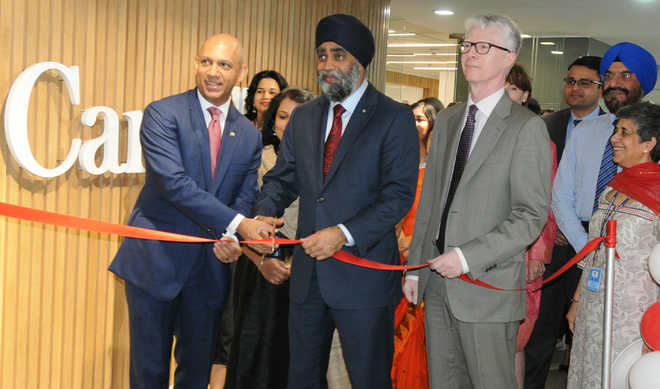 Canadian Defence Minister Harjit Singh Sajjan inaugurates the Consulate General’s office at Elante Mall in Chandigarh on Friday. Tribune photo
Canadian Defence Minister Harjit Singh Sajjan inaugurates the Consulate General’s office at Elante Mall in Chandigarh on Friday. Tribune photoSandeep Dikshit
Tribune News Service
Chandigarh, April 21
Canadian Defence Minister Harjit Singh Sajjan wound up his Punjab visit today by regretting the lack of conversation with Chief Minister Capt Amarinder Singh for investment opportunities. Both former military officers did not have a face-to-face meeting as the Punjab Chief Minister termed the Canadian a Khalistani sympathiser.The pitch was queered on the eve of his departure to India after a Canadian provincial assembly passed a resolution that termed the 1984 killings of Sikhs as genocide.In a conversation squeezed between the inauguration of the Canadian Consulate General’s office and departure to Mumbai to interact with industrialists, Sajjan said his Government was “ready for a conversation with the Punjab CM regarding investment opportunities”.Having been hounded for reactions to Capt Amarinder’s rather unusual boycott of a son-of-the-soil from a country that has hit the economic sweet-spot and, therefore, well placed to provide investments Punjab sorely needs, Sajjan added a caveat: “We don’t get involved in the politics of other nations. Neither do we like others getting involved in our affairs.”Sajjan, one of the few Sikhs to make it to the political high table of another nation, sought to rid the notion that his was a personality-driven trip although it had some personal moments such as the obeisance at the Golden Temple or a visit to a Jalandhar charity. “It’s no secret that Prime Minister Justin Trudeau wants to reach out to India. That is why several ministers have visited India to introduce ourselves for greater dialogue.”He felt the time had come for overseas Punjabis to have a bigger vision for investment rather than pouring money into building palatial mansions in their home villages. “This is tremendous but a lost opportunity as well. There is very little concrete investment [by them] in Punjab,” he commented. In fact, the trend is the other way round, he noted. There are over 1,000 Indian companies that have invested about $15 billion in Canada but there is very little Canadian investment coming to Punjab.Canada, the world’s sixth largest exporter of military hardware, was keen to get a bite of the lucrative Indian defence sector but indicated that these were early days. But civil nuclear energy, a scaffolding for strategic ties with India, was performing well. Uranium shipments have started arriving in India and the conversation has expanded to reactor technology.
Canadian minister slept on cot in village Bambeli (Hoshiarpur): Many residents of Bambeli, the ancestral village of Canadian Defence Minister Harjit Singh Sajjan, finally got to meet him on Thursday night. Earlier, security personnel had not allowed him to enter the pandal where villagers had made arrangements to welcome him. Sajjan had dal-roti and kheer for dinner and slept on a cot on the rooftop of his ancestral house. He met his relatives and members of the panchayat. Sajjan expressed satisfaction over the development works carried out in the village. Sarpanch Paramjit Singh said Sajjan went down memory lane, fondly recalling his childhood days. Early on Friday morning, he had paranthas with curd and pickle before leaving for Chandigarh. –Sanjiv Kumar Bakshi
Tie-up with Israel for police training
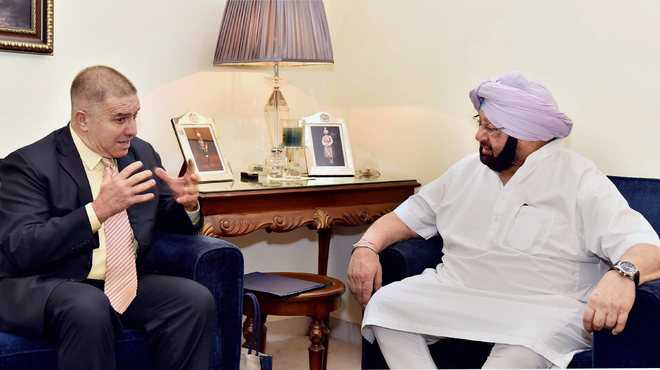 Chief Minister Capt Amarinder Singh with Israeli Ambassador Daniel Carmon in New Delhi on Friday. PTI
Chief Minister Capt Amarinder Singh with Israeli Ambassador Daniel Carmon in New Delhi on Friday. PTI
- The Punjab Government and Israel on Friday discussed cooperation in police and security training, and decided to explore the possibility of setting up the Punjab Special Operation Group
- Chief Minister Capt Amarinder Singh and Israel’s Ambassador to India Daniel Carmon met in New Delhi
- The Ambassador proposed that the training could be arranged either in Punjab or his country
- A government spokesperson said the exchange of technology, agriculture and irrigation and dairy farming were other matters on which Israel evinced interest in strengthening cooperation with Punjab
- The two sides decided to explore the possibility of setting up Punjab-Israel ‘Working Group’ for dialogue on matters of mutual interest
CM prunes own security cover
Tribune News Service
Chandigarh, April 21
The state government today announced the withdrawal of about 2,000 police personnel on security duty, including those attached with the Chief Minister and his family.As many as 376 personnel have been withdrawn from the CM’s security (down from 1,392 to 1,016).Around 1,500 security personnel have been withdrawn in other categories of constitutional and government functionaries, according to an official spokesperson.The orders were issued during a review meeting chaired by the Chief Minister and attended by Chief Principal Secretary Suresh Kumar, DGP Suresh Arora and ADGP (Intelligence) Dinkar Gupta in New Delhi today.The spokesperson said the CM’s security was likely to be cut down further after the next round of review, based on fresh reports on threat perceptions.
Govt cuts down VIP security
AMARINDER TRIMMED HIS OWN SECURITY FROM 1,392 TO 1,016 MEN AND ALSO ORDERED WITHDRAWAL OF 1,500 MORE COPS FROM OTHER CATEGORIES
Punjab government on Friday cut down on VIP security, including that of the chief minister Captain Amarinder Singh, by 2,000 personnel and decided to deploy them to ensure better policing and improve the law-and-order situation in the state.
The CM cut down his own security from 1,392 to 1,016 men and also ordered withdrawal of 1,500 more cops from other categories.
The decision was taken by the CM during a security review meeting held in the presence of principal chief secretary Suresh Kumar, director general of police (DGP) Suresh Arora and ADGP (intelligence) Dinkar Gupta.
An official spokesperson said the move was aimed at creating infrastructure for better policing by diverting precious resources to the more important and essential task of ensuring law and order in the state. The CM has made it clear that he does not want any security beyond bare necessity.
With a view to check the unbridled proliferation of arms in the hands of criminals and gangsters, the CM has also directed the police to review the arms and ammunition licences issued in the state.
Expressing concern at the threat posed to internal security as a result of the arms proliferation, which has led to several incidents of violation of law and order in Punjab recently, the CM also directed the district magistrates and police commissionerates to conduct a propriety audit of the arms licences issued after the notification of the Arms Rules, 2016, wef July 15, 2016, to date.
The spokesperson said the move, aimed at ensuring strict compliance under the provisions of the Arms Act, 1959 and the Arms Rules, 2016, will help control the lawlessness prevailing in the state as a result of the armed gangs who had a free run under the erstwhile SAD-BJP regime.
Police to review arms licences
Ravi S Singh
Tribune News Service
New Delhi, April 21
Punjab Chief Minister Capt Amarinder Singh convened a security review meeting here today, directing the police authorities to conduct audit of arms and ammunition licences.He expressed concern at the threat posed to internal security as a result of arms proliferation, which he said accounted for increasing incidents of breach of law in the recent past.Chief Principal Secretary Suresh Kumar, DGP Suresh Arora and ADGP (Intelligence) Dinkar Gupta were present in the meeting.Capt Amarinder directed review of arms licences issued after the notification of the Arms Rules, 2016, with effect from July 15, 2016, to date. The antecedent verification of the licencees, where needed, would also be done as per new norms, a government spokesperson said.“The move, aimed at ensuring compliance with the Arms Act, 1959, and the Arms Rules, 2016, will help control lawlessness in the state. During the previous SAD-BJP rule, armed gangs became active and took centre stage,” the spokesperson said.“The DGP has said that 57 gangs are active in the state. Several incidents of gang wars, jailbreaks and killings have been reported in recent months, causing concern to the Capt Amarinder government,” the spokesperson added.The CM also directed the police to frame a policy for disposal and destruction of confiscated, captured, seized, recovered or surrendered arms and ammunition.CM meets Uma BhartiCapt Amarinder met Union Water Resources Minister Uma Bharti on Friday, a day after her ministry met Chief Secretaries of Punjab and Haryana to find a solution to the SYL canal imbroglio. The water-related matter figured during the discussion, though it not on the agenda.
Engg colleges to conduct third-party audit of works
Ruchika M Khanna
Tribune News Service
Chandigarh, April 21
Top engineering colleges in Punjab will be conducting the third-party audit (TPA) of 60,666 works ordered by the previous Akali BJP government in villages across the state.Thapar Engineering College, Patiala; Lovely Professional University, Phagwara; and Maharaja Ranjit Singh Technical University, Bathinda; will check whether the material used for laying roads, water supply, sewerage, sewage treatment plants were according to the technical specifications specified under the Rural Urban Mission.Rural Development Minister Tript Rajinder Singh Bajwa said the TPA would be ordered next week, adding that the engineering colleges would be asked to check the quality of works.Sources told The Tribune that the previous government had ordered 60,666 works in 13,050 villages. After the change of guard, works where the project had been awarded but the contracts had not been approved were stopped. Many of the ongoing projects under the Urban Rural Mission had been put on hold.A review of such projects has revealed that 33,929 works have already been completed, while 22,000 works are under process. Only 4,000 works were yet to be started. The cost of the projects awarded by the Akali-BJP government was Rs2,355 crore and Rs2,129 crore have already been spent/disbursed to the Panchayati Raj Institutions (PRI) or the executing agencies.The funding for the Rural Mission was done by the Punjab Infrastructure Development Board, though some funds received by the state under the 14th Finance Commission were also used.Sources said while the entire funds released by PIDB had been spent, the money was yet to be released by the Finance Commission.
Projects on hold
- The SAD-BJP government had ordered 60,666 works in 13,050 villages. After the change of guard, works where the project had been awarded but the contracts had not been approved were stopped. Many of the ongoing projects under the Urban Rural Mission has been put on hold.
Minister faces students’ ire
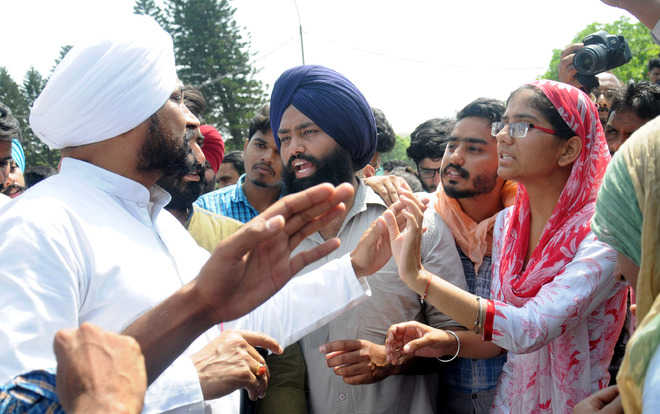 SFS activists argue with Punjab Cabinet Minister Charanjit Singh Channi during a protest at the PU in Chandigarh on Friday. Tribune photo: Pradeep Tewari
SFS activists argue with Punjab Cabinet Minister Charanjit Singh Channi during a protest at the PU in Chandigarh on Friday. Tribune photo: Pradeep TewariCharu Chhibber
Tribune News Service
Chandigarh, April 21
Punjab Technical Education Minister Charanjit Singh Channi today visited Panjab University amid anti-Punjab government slogans by the Joint Students’ Action Committee (JSAC). He was accompanied by Dhuri MLA Dalvir Singh Khangura (Goldy), who is also a former president of the Panjab University Campus Students’ Council (PUCSC).After a brief meeting with supporters of the NSUI, Channi went to meet supporters of the committee outside the VC’s office where they had been protesting against the fee hike. Taking over the microphone, Channi attempted to address the students but was cut short before he could even say a word as the protesters started raising anti-Punjab government slogans.The minister then moved to meet VC Arun Kumar Grover. However, in the absence of the VC, he met the officiating DUI along with other officials of the university. After a meeting that lasted about 15 minutes, Channi informed the students that a meeting has been scheduled between officials of the PU and the Punjab Government for April 25 at 6 pm , wherein Punjab Finance Minister Manpreet Singh Badal will also be present.“Panjab University offers high quality education to all and is amongst India’s top universities. The kind of problem that the university is facing is really unfortunate and the Punjab Government will try to do its best to resolve the issue,” said the minister. Channi then went to meet supporters of the JSAC. “I am here as a student. I have no political agenda. I just want that the tension between students and the PU authorities ease out,” he remarked.The protesters then asked him to join their protest. Channi agreed and sat down on the road, along with the sprotesters. However, when he got up to say something on the issue with folded hands, the protesters started raising anti-government slogans, thinking that he might leave. This evoked sharp criticism from the protesters, who said it was the common student who can bear the scorching summer sun and fight for their rights, “leaders don’t sit on the road,” they said. The minister then left in a hurry.
Another student seeks anticipatory bailAnother student protester, Prabhjit, filed an anticipatory bail plea in a local court on Friday. The court has already served issued a notice to the UT Police to file a reply in regard with anticipatory bail plea of 10 PU students in the fee hike protest case. The notice has been issued for April 24. The bail application stated the police had lodged a false and frivolous complaint. A total of 66 students were booked and 53 arrested during the protest.
Capt’s power @₹5/unit promise to give ₹3,200-cr shocker to exchequer
CHANDIGARH: Chief minister Captain Amarinder Singh’s populist announcement of providing electricity at ₹5 per unit to all consumers (domestic, commercial and industry) in Punjab will put an additional burden of ₹3,200 crore on the state exchequer.

Though a final word from the state government on the revised power tariff is awaited, the Punjab State Electricity Regulatory Commission (PSERC) has worked out a rough estimate of the burden it will put on the state finances.
Waiting for the government’s nod, the PSERC has so far not released the tariff plan for 2017-18, which should be have been out on March 31. Sources say it has been deferred till May. “We need at least one more month to finalise the tariff after clarity on the subsidy,” said a PSERC functionary.
“I would fulfil the promise made by the CM and soon announce a roadmap and mechanism to be adopted for cheap electricity,” power minister Rana Gurjit Singh told HT.
In the 2016-17 fiscal, the Punjab government paid a subsidy of ₹5,200 crore for providing free electricity to farmers for tubewells. “If the government decides to charge ₹5 per unit from all consumers, it will put addition burden of at least ₹3,200 on state exchequer, bringing it close to the ₹10,000-crore mark,” said a PSERC official. In the last financial year, the government also paid a subsidy of ₹1,100 crore for providing power to the Scheduled Caste and below poverty line consumers.
PSERC figures reveal that all categories of consumers, except pumpsets used for agricultural purpose, consume about 32,000 million units in a year. The average landing cost of power to the consumer in Punjab is ₹6 per unit, so the additional ₹1 per unit had to be compensated by the state government.
Things are not simple as they look. Punjab State Power Corporation Limited (PSPCL) has sought a power hike of 20%. The hike, if allowed, will also be added to the power subsidy bill. Also, the state government has a bad track record of paying the farm sector subsidy amount to the PSPCL. The government failed to pay ₹1,235 crore of 2015-16 which was carried forward in 2016-17. The cash-strapped state government might face an uphill task to clear the subsidy amount, say experts.
TARIFF REBATE TO HAVE CASCADING EFFECT, SAYS MANPREET
Talking to HT, Punjab finance minister Manpreet Singh Badal said rebate on power tariff to all consumers would have a cascading effect on the state’s development. “This is a gamble, but we are ready for it. We are ready to give subsidised power to all consumers,” he said, adding that the state government don’t want to lose the existing industry (in the state) and subsidised power would be a big booster for it. Industry consumes about 70% of the total power in the state.
“In the 1960s, we were able to do build Punjab because of cheap and surplus power from the Bhakra Dam. We are trying to repeat that phenomenon by giving cheap power,” said Manpreet, adding that the government would make budgetary provisions for the power subsidy.
Punjab authorities forget Chappar Chiri memorial
Opened with much fanfare in 2011 to commemorate Banda Singh Bahadur’s historic win over Mughal governor, the country’s tallest victory tower, other structures cry for attention
We keep carrying out maintenance works at the memorial from time to time. The lights will be repaired soon. SUNIL KANSAL, chief engineer, GMADA
From page 01 SASNAGAR: Even as Haryana chief minister Manohar Lal Khattar visited Fateh Burj at Chappar Chiri in SAS Nagar to take inspiration for a memorial at Lohgarh, capital of the first Sikh state under Banda Singh Bahadur, in Yamunanagar district, the Punjab government seems to be struggling to maintain the tallest victory tower in the country.
 RAVI KUMAR/HTAn uncarpeted road leading to the war memorial at Chappar Chiri in SAS Nagar. Its condition is as bad as it was in 2012, when the previous Akali government organised its oathtaking ceremony at the memorial.
RAVI KUMAR/HTAn uncarpeted road leading to the war memorial at Chappar Chiri in SAS Nagar. Its condition is as bad as it was in 2012, when the previous Akali government organised its oathtaking ceremony at the memorial.
Fateh Burj, which commemorates the victory of Banda Singh Bahadur over Mughal governor Wazir Khan, was inaugurated with much fanfare by former Punjab chief minister Parkash Singh Badal in 2011. The 328-foot tower, dedicated to the Sikh warrior, is part of a memorial spread over 20 acres in Chappar Chiri. Set up at an estimated cost of ₹35 crore, the memorial made it to the heritage map of India.
Even though the memorial receives 2.2 lakh visitors annually, the Greater Mohali Area Development Authority (GMADA), responsible for its upkeep, has failed to perform its duty or attract more visitors.
POOR PLANNING HITS MAIN ATTRACTION
The main attraction of the memorial was the Fateh Burj illumination in the evening, which changed colours at regular intervals. The special lights, which cost ₹1 crore, have not been functioning for the past three months. Reason: Poor planning. The lights were installed before carrying out flooring on the premises. Later, when flooring was taken up, the lights were damaged. The staff present at the memorial said it was also not easy to clean the lights. They said the Akali government inaugurated the memorial in a hurry ahead of the 2012 assembly elections, even as its construction was not yet complete.
The memorial, in fact, is spruced up for political events, and later, the authorities hardly care to maintain it. The Punjab government even purchased a lift worth ₹80 lakh to be installed in the tower. It is lying in the basement for the past two years.
NOT A SINGLE SHOW AT THEATRE
A theatre, with a seating capacity of 100, was set up at the memorial to provide the visitors an immersive experience of the historic war that took place at Chappar Chiri in 1710. It’s been more than five years, but not a single show has been screened on the theatre so far.
BUMPY RIDE TO MEMORIAL
The drive to the memorial can give the visitors a fair idea of what lies ahead. The potholed road to the memorial has not been repaired for years. Its condition is as bad as it was in 2012, when the previous Akali government organised its oath-taking ceremony at the memorial.
EMPLOYEES SAY SALARIES NOT PAID
The employees at the memorial say they have not been paid their salaries for the past three months. There are 14 security guards deployed at the memorial besides 12 gardeners and labourers. The security guards are registered with a private company. A guard, on the condition of anonymity, said: “We have been performing our duties with sincerity, but our salaries have not being paid.”
‘REPAIRS UNDERWAY’
GMADA chief engineer Sunil Kansal said: “We keep carrying out maintenance works at the memorial from time to time. We are in touch with firms for maintenance of lights. They would be repaired soon.” An official present at the memorial said the flooring has been completed, while gates are being constructed to install the lift.
Punjab government to review policy regulating marriage palaces: Secy
SAS NAGAR: Department of housing and urban development, Punjab, will review the policy regulating the marriage palaces of the state, informed additional secretary of department to the members of the Association of Marriage Palace Owners in a meeting held on Friday .
 HT FILEOut of 1,180 marriage palaces outside the municipal limits in the state, 1,093 had applied for regularisation under the existing policy.
HT FILEOut of 1,180 marriage palaces outside the municipal limits in the state, 1,093 had applied for regularisation under the existing policy.
The subjects that will be taken up for consideration includes simplification of procedure for conditional no objection certificate (NoC), compounding of parking area up to 5%, rationalisation of regularisation charges, review of parking norms, payment of compounding charges and extension in the validity of existing policy.
The secretary said that whatever relief is possible within the policy framework will be provided to the palace owners.
The association will also take up the matter with Amarinder Singh, chief minister, Punjab, who is also minister heading the department of housing and urban development.
Members of the association claimed that the department is planning to provide better infrastructure and facilities to the public using these palaces.
The association during the meeting with the additional chief secretary demanded that change of land use (CLU) charges and other charges paid by the marriage palace owners should be at par with charges paid by the hotel industry.
They also asked him to scrap these charges from the palaces built before the year 2007 as there was no policy available at that time and cut-off date announced by the department was NovemThe ber 6, 2012.
The regularisation policy, notified on August 16, 2016 mandates the government to claim CLU on specified rates for regularisation of existing marriage palaces.
The members informed the department that more than 1,500 marriage palaces running in the state are unauthorised and list containing information about these palaces will be shared with the department.
Out of 1,180 marriage palaces outside municipal limits in the state, 1,093 had applied for the regularisation under the existing policy.
committee constituted for the purpose has declared 107 marriage palaces as regular and 364 have been granted change of land use (CLU) and demand notices have been issued to 340 applicants and 147 building plans have been approved.
Remaining applications are being processed for regularisation. Combining various components of the compounding fees, the department has received ₹38.84 crore. Regularisation of marriage palaces located within municipal limits has been undertaken by the department of local government, under this policy.
PRTC tightens noose around bus timetable inspectors
DISCOURAGING MONOPOLY Transport union says move will curb corruption in lower rungs; shifting back authority to transport head office will improve revenue generation
From page 01 LUDHIANA: A long-awaited demand of the bus transport union members bore fruit on Thursday as in its bid to curb corruption with regard to time slot allocations to private/public transport buses, the Pepsu Road Transport Corporation (PRTC) management has tightened its noose around timetable inspectors who were leveraging private players to ply on profitable routes during peak hours.
 HT FILECorruption was rampant in lower rungs of the corporation as a number of timetable inspectors allocated profitable time slots to some private players in the state, says PRTC managing director.
HT FILECorruption was rampant in lower rungs of the corporation as a number of timetable inspectors allocated profitable time slots to some private players in the state, says PRTC managing director.
The time slot adjustment is crucial when it comes to revenue generation. We had been seeking intervention of the authorities to rein in the nexus between private players and officials for long but our demands always fell on deaf ears. SURESH SOOD, general secretary, Indian National Trade Union Congress
Lauding the move, the transport union members said that the ill-practice was on for years without any check despite being in public glare, but shifting back the authority for time slot allocation to the state transport head office will improve revenue generation.
Pepsu Road Transport Corporation managing director Manjit Narang said, “The corruption was rampant in the lower rungs of the corporation as a number of timetable inspectors calling the shots in allocating profitable time slots to some private players in the state who greased their palms.”
He added, “The ill-practice had gotten to the PRTC and was causing substantial revenue losses in convenient way. I have issued instructions to respective general managers of all 11 depots in the state to not let the timetable inspectors to issue certificate for time allocation at their behest. Revocation of their powers to issue no objection certificate (NOCs) was much needed as there was hardly any intervention at the RTA’s end once time slots changes recommended by timetable inspectors.”
Narang added, “Until now the private players in the state were eating a larger share of PRTC fleet by plying on profitable routes during peak hours but now time slot allocation as well as alteration has to be sought from the head office.”
Suresh Sood, general secretary, Indian National Trade Union Congress (INTUC), said, “The ‘time slot adjustment’ is crucial when it comes to revenue generation. And we had been seeking intervention of the authorities to rein-in private players and officials nexus for long but our demand always fell on deaf ears and often passed off as a practice on for years. But a stringent stance of PRTC management against arbitrary time slot allocations will bode well for the corporation in the longer run.”
Sood added, “Besides being a step towards curbing corruption, the recent move by PRTC will discourage the monopoly of influential private bus companies in the state.”
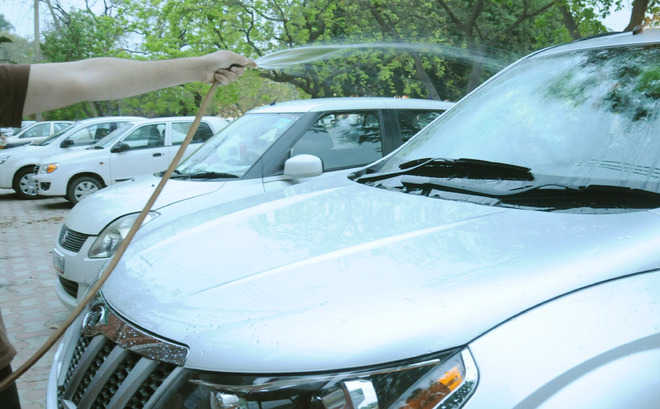












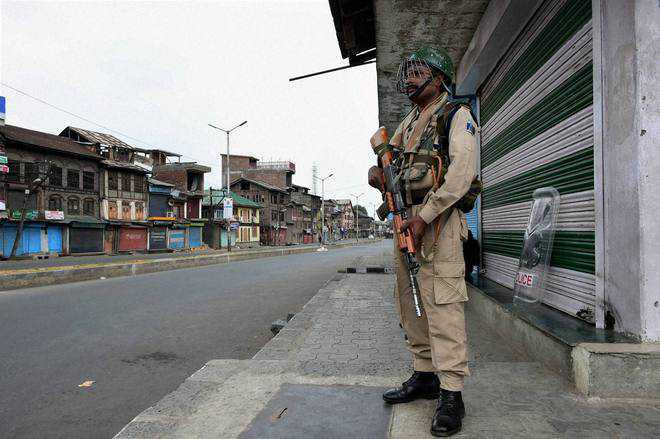
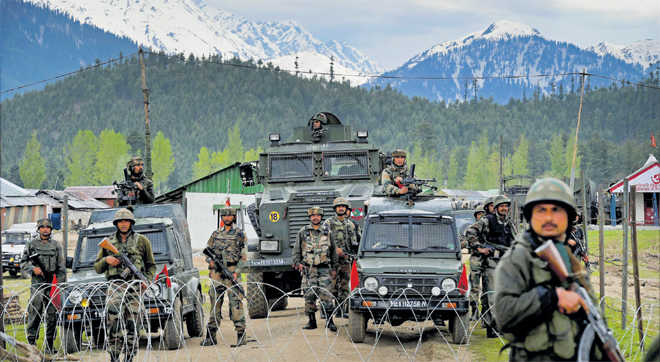
 HT FILE
HT FILE





 RAVI KUMAR/HT
RAVI KUMAR/HT HT FILE
HT FILE HT FILE
HT FILE